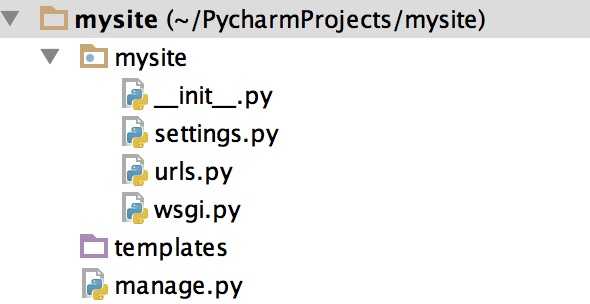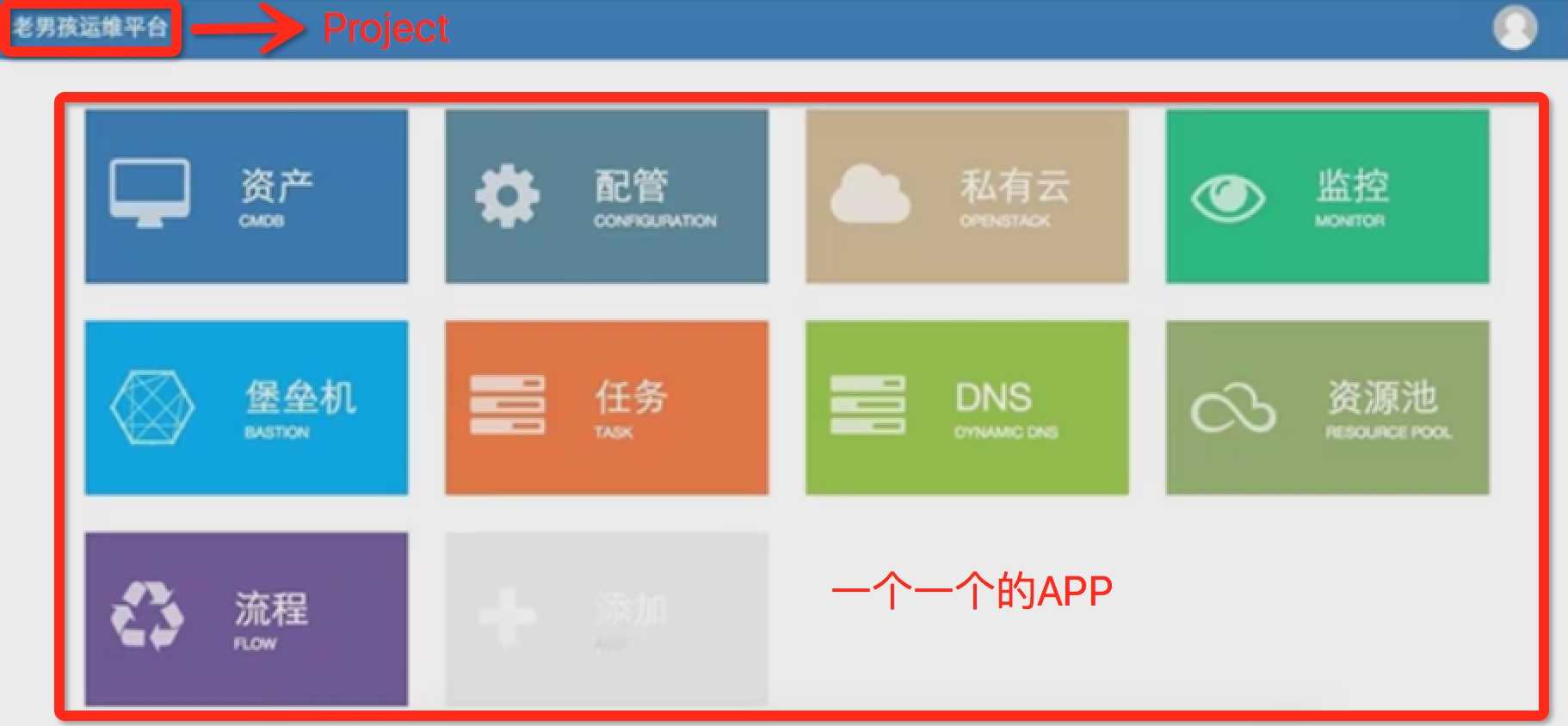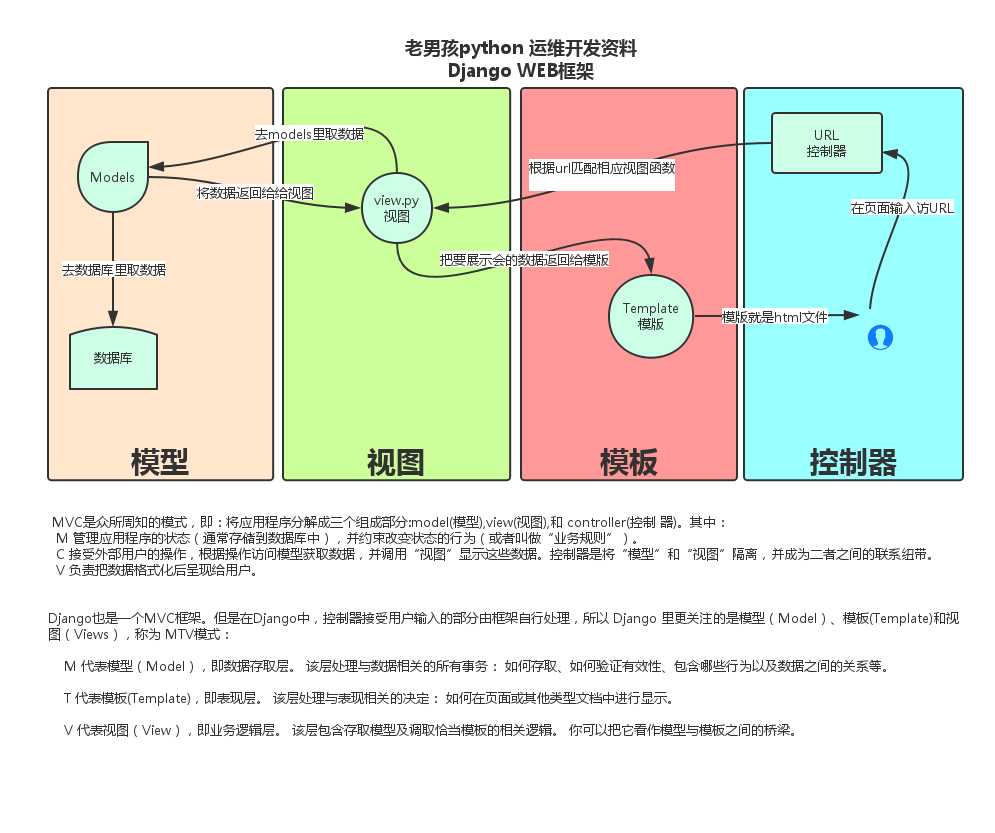标签:
python的web框架有Django、Tornado、Flask等多种,Django相较于其他web框架其优势大而全,而框架本身集成了ORM、模型绑定、模板引擎、缓存、session等诸多功能。
其他常用命令
python manage.py runserver 0.0.0.0:port python manage.py startapp appname python manage.py syncdb python manage.py makemigrations python manage.py migrate python manage.py createsuperuser

settings.py 配置文件 urls.py 路由映射系统 manage.py Django的启动管理程序

python manage.py startapp app01
如果在创建一个app,我们可以理解app是手机里的app程序他们之间是完全独立的,好处是降低他们之间的耦合性,不到万不得已不要他们之间建立关系!

app里面的admin是提供了后台管理的平台,test是用来测试的!
同步数据库
python manage.py syncdb #注意:django1.7.1及以上版本需要用以下命令 python manage.py makemigrations python manage.py migrate
创建超级用户
python manage.py createsuperuser
输入你要设置的用户名和密码,然后启动Django,然后输入:http://127.0.0.1:8000/admin/

DATABASES = {
‘default‘: {
‘ENGINE‘: ‘django.db.backends.mysql‘,
‘NAME‘:‘dbname‘,
‘USER‘: ‘root‘,
‘PASSWORD‘: ‘xxx‘,
‘HOST‘: ‘‘,
‘PORT‘: ‘‘,
}
}
# 由于Django内部连接MySQL时使用的是MySQLdb模块,而python3中还无此模块,所以需要使用pymysql来代替
# 如下设置放置的与project同名的配置的 __init__.py文件中
import pymysql
pymysql.install_as_MySQLdb()
TEMPLATE_DIRS = (
os.path.join(BASE_DIR,‘templates‘),
)
STATICFILES_DIRS = ( os.path.join(BASE_DIR,‘static‘), )
# 特有的静态文件夹放在app里面, # 模板里面使用静态文件 <script src="/static/jquery-1.12.4.js"></script>
MVC模式:所谓MVC就是把web应用分为模型(M),控制器(C),视图(V)三层,他们之间以一种插件似的,松耦合的方式连接在一起,模型负责业务对象与数据库对象(ORM),视图负责与用户的交互(页面),控制器(C)接受用户的输入调用模型和视图完成用户的请求。 
Django的MTV模式本质与MVC模式没有什么差别,也是各组件之间为了保持松耦合关系,只是定义上有些不同,Django的MTV分别代表:
此外,Django还有一个url分发器,它的作用是将一个个url的页面请求分发给不同的视图函数(View)处理,View再调用相应的Model和Template

参数说明
from django.conf.urls import url
from . import views
urlpatterns = [
# 一般
url(r‘^articles/2003/$‘, views.special_case_2003),
url(r‘^articles/([0-9]{4})/$‘, views.year_archive),
url(r‘^articles/(?P<year>[0-9]{4})/(?P<month>[0-9]{2})/$‘, views.month_archive),
# 路由分发(在MyDjango的urls使用include实现路由分发,并在app01下新建urls.py实现url映射)
url(r‘^contact/‘, include(‘app01.urls‘)),
# 传给视图的默认参数,对应的视图函数也必须加上同名的参数
url(r‘^blog/(?P<year>[0-9]{4})/$‘, views.year_archive, {‘foo‘: ‘bar‘}),
#name参数
url(r‘^index‘,views.index,name=‘bieming‘),
]
在urls.py里添加对应url关系
from django.conf.urls import patterns, include, url
#首先要从app01里导入views
from app01 import views
from django.contrib import admin
admin.autodiscover()
urlpatterns = patterns(‘‘,
# Examples:
# url(r‘^$‘, ‘my_django.views.home‘, name=‘home‘),
# url(r‘^blog/‘, include(‘blog.urls‘)),
url(r‘^admin/‘, include(admin.site.urls)),
url(r‘^index/‘, views.index),
)
并在app里views.py里添加函数
from django.shortcuts import render
#django在返回的时候需要一层封装,需要导入HttpResponse
from django.shortcuts import HttpResponse
# Create your views here.
def index(req):
return HttpResponse(‘<h1>hello index</h1>‘)
django中的路由系统和其他语言的框架有所不同,在django中每一个请求的url都要有一条路由映射,这样才能将请求交给对一个view中的函数去处理,其他大部分的web框架则是对一类的url请求做一条路由映射,从而使得路由系统变得简洁。
启动:IDE启动和命令行启动(python manage.py runserver 127.0.0.1:6666)
返回html
from django.shortcuts import render
#django在返回的时候需要一层封装,需要导入HttpResponse
from django.shortcuts import HttpResponse
# Create your views here.
# def index(req):
# return HttpResponse(‘<h1>hello index</h1>‘)
def home(req):
#找到home.html
#读取并返回给客户端
return render(req,‘home.html‘)
最后要记得在settings里面注册app
实例写法:
urlpatterns = patterns(‘‘,
# Examples:
# url(r‘^$‘, ‘my_django.views.home‘, name=‘home‘),
# url(r‘^blog/‘, include(‘blog.urls‘)),
url(r‘^admin/‘, include(admin.site.urls)),
#给index这url别名,前端可通过别名来进行提交
url(r‘^index/‘, views.index,name=‘eric‘,),
# 在视图函数里添加一个默认参数name,值为alex
url(r‘^car/‘, views.car, {‘name‘: ‘alex‘}),
# url(r‘^home/‘, views.home),
)
def index(req):
if req.method == ‘POST‘:
username = req.POST.get(‘username‘)
print(username)
if username == ‘alex‘:
return HttpResponse(‘you are de right‘)
else:
return HttpResponse(‘error‘)
return render(req,‘index.html‘)
def car(req,name):
return HttpResponse(‘car‘+name)
<body>
<form action="{% url ‘eric‘ %}" method="post">
{% csrf_token %}
<input type="text" name="username"/>
<input type="submit" value="提交"/>
</form>
</body>
主要围绕HttpRequest对象和Httpresponse对象
# path: 请求页面的全路径,不包括域名 # # method: 请求中使用的HTTP方法的字符串表示。全大写表示。例如 # # if req.method=="GET": # # do_something() # # elseif req.method=="POST": # # do_something_else() # # GET: 包含所有HTTP GET参数的类字典对象 # # POST: 包含所有HTTP POST参数的类字典对象 # # 服务器收到空的POST请求的情况也是可能发生的,也就是说,表单form通过 # HTTP POST方法提交请求,但是表单中可能没有数据,因此不能使用 # if req.POST来判断是否使用了HTTP POST 方法;应该使用 if req.method=="POST" # # # # COOKIES: 包含所有cookies的标准Python字典对象;keys和values都是字符串。 # # FILES: 包含所有上传文件的类字典对象;FILES中的每一个Key都是<input type="file" name="" />标签中 name属性的值,FILES中的每一个value同时也是一个标准的python字典对象,包含下面三个Keys: # # filename: 上传文件名,用字符串表示 # content_type: 上传文件的Content Type # content: 上传文件的原始内容 # # # user: 是一个django.contrib.auth.models.User对象,代表当前登陆的用户。如果访问用户当前 # 没有登陆,user将被初始化为django.contrib.auth.models.AnonymousUser的实例。你 # 可以通过user的is_authenticated()方法来辨别用户是否登陆: # if req.user.is_authenticated();只有激活Django中的AuthenticationMiddleware # 时该属性才可用 # # session: 唯一可读写的属性,代表当前会话的字典对象;自己有激活Django中的session支持时该属性才可用。
HttpRequest对象的方法.:get_full_path(),获取相对路径(比如:http://127.0.0.1:8000/index33/?name=123 ,req.get_full_path()得到的结果就是/index33/?name=123)
对于HttpRequest对象来说,是由django自动创建的,但是,HttpResponse对象就必须由我们自己创建,每个视图函数处理请求最后必须返回一个HttpResponse对象(render本质找到html文件,读取文件内容通过HttpResponse对象返回),HttpResponse类必须自行导入
在HttpResponse对象扩展的常用方法:
<body>
<h1>hello wupeiqi</h1>
<h1>{{ name }}</h1>
</body>
def index1(req):
name = ‘alex‘
# return render(req,‘index.html‘,{‘name‘:‘alex‘}) #渲染,字典传值
# return redirect(‘http://www.baidu.com‘) #跳转
return render_to_response(‘index.html‘,locals()) #locals传值
from django.db import models
# Create your models here.
class UserType(models.Model):
nid = models.AutoField(primary_key=True)
caption = models.CharField(max_length=32)
class UserInfo(models.Model):
user = models.CharField(max_length=16)
pwd = models.CharField(max_length=16)
email = models.EmailField()
userType = models.ForeignKey(UserType)
class Group(models.Model):
name = models.CharField(max_length=16)
h2g = models.ManyToManyField(‘Host‘)
class Host(models.Model):
hostname = models.CharField(max_length=16)
ip = models.CharField(max_length=16)
from django.contrib import admin from app01 import models # Register your models here. admin.site.register(models.UserInfo) admin.site.register(models.UserType) admin.site.register(models.Group) admin.site.register(models.Host)
# 第一种方式创建
# usertype = models.UserType(caption=‘管理员‘)
# usertype.save()
# 第二种方式创建
# models.UserType.objects.create(caption=‘普通用户‘)
# 第三种
# userTypeDict = {‘caption‘: ‘协管员‘}
# models.UserType.objects.create(**userTypeDict)
# 带外键添加数据库 推荐使用
# userInfoDict = {
# ‘user‘: ‘jason‘,
# ‘email‘: ‘jason123@qq.com‘,
# ‘pwd‘: ‘123‘,
# ‘userType_id‘: 2,
# }
# userInfoDict = {
# ‘user‘: ‘jason2‘,
# ‘email‘: ‘jason26663@qq.com‘,
# ‘pwd‘: ‘123‘,
# ‘userType‘: models.UserType.objects.filter(nid=2).first(),
# }
# models.UserInfo.objects.create(**userInfoDict)
# 删除
# models.UserType.objects.filter(nid=3).delete()
# 修改
# models.UserType.objects.filter(nid=1).update(caption=‘超级管理员‘)
# 查询 查询结果是QuerySet
# ret = models.UserType.objects.all() # select会获取所有的映射
# print(type(ret), ret, ret.query) # ret 里面保存的是对象
# ret = models.UserType.objects.all().values(‘nid‘) # 获取指定映射
# print(type(ret), ret, ret.query) # ret 里面保存的是字典
# ret = models.UserType.objects.all().values_list(‘nid‘) # 获取指定映射
# print(type(ret), ret, ret.query) # ret 里面保存的是元祖
一对多查找操作
# 连表 双下划线使用,注意什么情况下使用 表名_set 什么情况下使用 表名__字段
# (表名_set 获取QuerySet对象) (表名__字段,查找过滤映射的时候用)
# 正向查找,再多的一方查找一的一方
# ret = models.UserInfo.objects.all().values(‘user‘, ‘userType__caption‘)
# print(ret)
# ret = models.UserInfo.objects.filter(userType__caption="普通用户").values(‘user‘, ‘userType__caption‘)
# print(ret)
# 反向查找 在一的一方查找多的一方
# 在获取了一对多中一那一方的对象之后,要获取多的那一方对象使用反向表名_set
# ret = models.UserType.objects.filter(caption=‘普通用户‘).first()
# print(ret.nid, ret.userinfo_set, ret.userinfo_set.all(), ret.userinfo_set.all()[0].user)
# 直接在一对多一那一方使用查找或者过滤映射的时候使用反向表名__字段
# ret = models.UserType.objects.all().values(‘caption‘, ‘userinfo__user‘)
# print(ret)
建立一对一(外键,唯一)
user_type = models.Foreignkey("UserType",unique=True)
user_type = models.OneToOneField("UserType")
多对多操作
‘‘‘
创建表:
直接使用m2m
自已定义第三张表
自已定义第三张表 + m2m(through) 可以通过through参数来指明存在的表
直接使用m2m
--- 获取值
add添加
remove删除(关系表),filter.delete()(关系表+..)
set设置(添加、删除)
get_or_create
update_or_create
自已定义第三张表 + m2m + through
--关系表只能获取值 filter,all...
通过第三张表进行操作
‘‘‘
‘‘‘
# 直接使用
class Host(models.Model):
hid = models.AutoField(primary_key=True)
hostname = models.CharField(max_length=32)
ip = models.CharField(max_length=32)
# h2g = models.ManyToManyField(‘Group‘)
class Group(models.Model):
gid = models.AutoField(primary_key=True)
name = models.CharField(max_length=16)
h2g = models.ManyToManyField(‘Host‘)
# 自定义第三张表
# class Host(models.Model):
# hid = models.AutoField(primary_key=True)
# hostname = models.CharField(max_length=32)
# ip = models.CharField(max_length=32)
# # h2g = models.ManyToManyField(‘Group‘, through=‘HostToGroup‘)
# class Group(models.Model):
# gid = models.AutoField(primary_key=True)
# name = models.CharField(max_length=16)
#
# h2g = models.ManyToManyField(‘Host‘)
#
# class HostToGroup(models.Model):
# hgid = models.AutoField(primary_key=True)
# host_id = models.ForeignKey(‘Host‘)
# group_id = models.ForeignKey(‘Group‘)
# status = models.IntegerField()
# class Meta:
# # index_together = ("host_id",‘goup_id‘) 组合索引
# unique_together = [
# (‘host_id‘, ‘group_id‘), 组合唯一索引
# ]
‘‘‘
多对多方法
反向,不存在多对多字段一方获取对象---对象.对方表名_set.set() 数据修改(之前有,现有--保留;之前有,现无--删除;之前无,现有--添加,四个字--去旧照新),clear=True,全删了,然后再添加
# 将多台机器分给一组 正向
# obj = models.Group.objects.get(id=1)
# hosts = models.Host.objects.filter(id__gt=2)
# obj.h2g.add(*hosts)
# host = models.Host.objects.get(id=2)
# obj.h2g.add(host)
# 给多个组分一台机器 反向
# h = models.Host.objects.get(id=1)
# h.group_set.add(*models.Group.objects.filter(id__gt=2))
# h.group_set.add(2) # 可以直接添加id或对象
# h.group_set.remove(*models.Group.objects.filter(id__gt=3)) # 只删除关系表
# h.group_set.filter(id__gt=2).delete() # group_id>2 的关系表删除了,相应的group表数据也被删除了
# h.group_set.set(models.Group.objects.filter(id__gt=1), clear=True) #大于1的全部清除在添加
# h.group_set.set(models.Group.objects.filter(id__gt=2)) # 大于2 以前存在的不清除,不存在的添加
# h.group_set.set(models.Group.objects.filter(id__gt=4)) # 小于5的被清除
# r = h.group_set.update_or_create(name=‘人事部‘) # 两张表都不存在,先在group表创建在添加到关系表中去
# print(r)
# r = h.group_set.update_or_create(name=‘pm‘) # 和上面的效果一样,为什么
# h.group_set.get_or_create(name=‘te‘) # 和上面的效果一样
一次性插多条数据
author_list = []
for i in range(7):
name = ‘alex‘ + str(i)
age = i
author = models.Author(name=name, age=age)
author_list.append(author)
models.Author.objects.bulk_create(author_list)

1、models.AutoField 自增列 = int(11) 如果没有的话,默认会生成一个名称为 id 的列,如果要显示的自定义一个自增列,必须将给列设置为主键 primary_key=True。 2、models.CharField 字符串字段 必须 max_length 参数 3、models.BooleanField 布尔类型=tinyint(1) 不能为空,Blank=True 4、models.ComaSeparatedIntegerField 用逗号分割的数字=varchar 继承CharField,所以必须 max_lenght 参数 5、models.DateField 日期类型 date 对于参数,auto_now = True 则每次更新都会更新这个时间;auto_now_add 则只是第一次创建添加,之后的更新不再改变。 6、models.DateTimeField 日期类型 datetime 同DateField的参数 7、models.Decimal 十进制小数类型 = decimal 必须指定整数位max_digits和小数位decimal_places 8、models.EmailField 字符串类型(正则表达式邮箱) =varchar 对字符串进行正则表达式 9、models.FloatField 浮点类型 = double 10、models.IntegerField 整形 11、models.BigIntegerField 长整形 integer_field_ranges = { ‘SmallIntegerField‘: (-32768, 32767), ‘IntegerField‘: (-2147483648, 2147483647), ‘BigIntegerField‘: (-9223372036854775808, 9223372036854775807), ‘PositiveSmallIntegerField‘: (0, 32767), ‘PositiveIntegerField‘: (0, 2147483647), } 12、models.IPAddressField 字符串类型(ip4正则表达式) 13、models.GenericIPAddressField 字符串类型(ip4和ip6是可选的) 参数protocol可以是:both、ipv4、ipv6 验证时,会根据设置报错 14、models.NullBooleanField 允许为空的布尔类型 15、models.PositiveIntegerFiel 正Integer 16、models.PositiveSmallIntegerField 正smallInteger 17、models.SlugField 减号、下划线、字母、数字 18、models.SmallIntegerField 数字 数据库中的字段有:tinyint、smallint、int、bigint 19、models.TextField 字符串=longtext 20、models.TimeField 时间 HH:MM[:ss[.uuuuuu]] 21、models.URLField 字符串,地址正则表达式 22、models.BinaryField 二进制 23、models.ImageField 图片 24、models.FilePathField 文件

1、null=True 数据库中字段是否可以为空 2、blank=True django的 Admin 中添加数据时是否可允许空值 3、primary_key = False 主键,对AutoField设置主键后,就会代替原来的自增 id 列 4、auto_now 和 auto_now_add auto_now 自动创建---无论添加或修改,都是当前操作的时间 auto_now_add 自动创建---永远是创建时的时间 5、choices GENDER_CHOICE = ( (u‘M‘, u‘Male‘), (u‘F‘, u‘Female‘), ) gender = models.CharField(max_length=2,choices = GENDER_CHOICE) 6、max_length 7、default 默认值 8、verbose_name Admin中字段的显示名称 9、name|db_column 数据库中的字段名称 10、unique=True 不允许重复 11、db_index = True 数据库索引 12、editable=True 在Admin里是否可编辑 13、error_messages=None 错误提示 14、auto_created=False 自动创建 15、help_text 在Admin中提示帮助信息 16、validators=[] 17、upload-to

# 获取个数 # # models.Tb1.objects.filter(name=‘seven‘).count() # 大于,小于 # # models.Tb1.objects.filter(id__gt=1) # 获取id大于1的值 # models.Tb1.objects.filter(id__lt=10) # 获取id小于10的值 # models.Tb1.objects.filter(id__lt=10, id__gt=1) # 获取id大于1 且 小于10的值 # in # # models.Tb1.objects.filter(id__in=[11, 22, 33]) # 获取id等于11、22、33的数据 # models.Tb1.objects.exclude(id__in=[11, 22, 33]) # not in # contains # # models.Tb1.objects.filter(name__contains="ven") # models.Tb1.objects.filter(name__icontains="ven") # icontains大小写不敏感 # models.Tb1.objects.exclude(name__icontains="ven") # range # # models.Tb1.objects.filter(id__range=[1, 2]) # 范围bettwen and # 其他类似 # # startswith,istartswith, endswith, iendswith, # order by # # models.Tb1.objects.filter(name=‘seven‘).order_by(‘id‘) # asc # models.Tb1.objects.filter(name=‘seven‘).order_by(‘-id‘) # desc # limit 、offset # # models.Tb1.objects.all()[10:20] # group by from django.db.models import Count, Min, Max, Sum # models.Tb1.objects.filter(c1=1).values(‘id‘).annotate(c=Count(‘num‘)) # SELECT "app01_tb1"."id", COUNT("app01_tb1"."num") AS "c" FROM "app01_tb1" WHERE "app01_tb1"."c1" = 1 GROUP BY "app01_tb1"."id"

# F 使用查询条件的值 # # from django.db.models import F # models.Tb1.objects.update(num=F(‘num‘)+1) # Q 构建搜索条件 from django.db.models import Q # con = Q() # # q1 = Q() # q1.connector = ‘OR‘ # q1.children.append((‘id‘, 1)) # q1.children.append((‘id‘, 10)) # q1.children.append((‘id‘, 9)) # # q2 = Q() # q2.connector = ‘OR‘ # q2.children.append((‘c1‘, 1)) # q2.children.append((‘c1‘, 10)) # q2.children.append((‘c1‘, 9)) # # con.add(q1, ‘AND‘) # con.add(q2, ‘AND‘) # # models.Tb1.objects.filter(con) # # from django.db import connection # cursor = connection.cursor() # cursor.execute("""SELECT * from tb where name = %s""", [‘Lennon‘]) # row = cursor.fetchone()

<!DOCTYPE html> <html lang="en"> <head> <meta charset="UTF-8"> <title>Title</title> <style> .left{ float: left; } .clearfix:after{ content: ‘.‘; clear: both; display: block; visibility: hidden; height: 0; } </style> </head> <body> <div class="condition"> <div class="item clearfix"> <div class="icon left" onclick="AddCondition(this);">+</div> <div class="left"> <select onchange="ChangeName(this);"> <option value="name">书名</option> <option value="book_type__caption">图书类型</option> <option value="price">价格</option> <option value="pages">页数</option> </select> </div> <div class="left"><input type="text" name="name" /></div> </div> </div> <div> <input type="button" onclick="Search();" value="搜索" /> </div> <div class="container"> </div> <script src="/static/jquery-1.12.4.js"></script> <script> function AddCondition(ths) { var new_tag = $(ths).parent().clone(); new_tag.find(‘.icon‘).text(‘-‘); new_tag.find(‘.icon‘).attr(‘onclick‘, ‘RemoveCondition(this);‘); $(ths).parent().parent().append(new_tag); } function RemoveCondition(ths) { $(ths).parent().remove(); } function ChangeName(ths) { var v = $(ths).val(); $(ths).parent().next().find(‘input‘).attr(‘name‘,v); } function Search() { var post_data_dict = {}; // 获取所有input的内容,提交数据 $(‘.condition input‘).each(function () { // console.log($(this)[0]) var n = $(this).attr(‘name‘); var v = $(this).val(); var v_list = v.split(‘,‘); post_data_dict[n] = v_list; }); console.log(post_data_dict); var post_data_str = JSON.stringify(post_data_dict); $.ajax({ url: ‘/index/‘, type: ‘POST‘, data: { ‘post_data‘: post_data_str}, dataType: ‘json‘, success: function (arg) { // 字符串 "<table>" + if(arg.status){ var table = document.createElement(‘table‘); table.setAttribute(‘border‘,1); // [{,name,pubdate,price,caption},] $.each(arg.data, function(k,v){ var tr = document.createElement(‘tr‘); var td1 = document.createElement(‘td‘); td1.innerText = v[‘name‘]; var td2 = document.createElement(‘td‘); td2.innerText = v[‘price‘]; var td3 = document.createElement(‘td‘); td3.innerText = v[‘book_type__caption‘]; var td4 = document.createElement(‘td‘); td4.innerText = v[‘pubdate‘]; tr.appendChild(td1); tr.appendChild(td2); tr.appendChild(td3); tr.appendChild(td4); table.appendChild(tr); }); $(‘.container‘).empty(); $(‘.container‘).append(table); }else{ alert(arg.message); } } }) } </script> </body> </html>

from django.db import models # Create your models here. class Author(models.Model): name = models.CharField(max_length=32) age = models.IntegerField() class BookType(models.Model): caption = models.CharField(max_length=32) class Book(models.Model): name = models.CharField(max_length=64) price = models.DecimalField(max_digits=10, decimal_places=2) pubdate = models.DateField() authors = models.ManyToManyField(Author) book_type = models.ForeignKey(BookType)

from django.shortcuts import render,HttpResponse from app01 import models # Create your views here. import json def test(request): # models.BookType.objects.create(caption=‘技术‘) # models.BookType.objects.create(caption=‘文学‘) # models.BookType.objects.create(caption=‘动漫‘) # models.BookType.objects.create(caption=‘男人装‘) # models.Book.objects.create(name=‘文艺复兴‘,pages=‘100‘,price=‘40‘,pubdate=‘1992-11-2‘,book_type_id=‘1‘) # models.Book.objects.create(name=‘解密‘,pages=‘80‘,price=‘10‘, pubdate=‘2016-6-10‘,book_type_id=‘2‘) # models.Book.objects.create(name=‘刀锋‘,pages=‘50‘,price=‘3‘, pubdate=‘2014-02-16‘,book_type_id=‘2‘) # models.Book.objects.create(name=‘查令十字路84号‘,pages=‘260‘,price=‘40‘,pubdate=‘1999-10-12‘,book_type_id=‘3‘) # models.Book.objects.create(name=‘红楼‘,pages=‘1000‘,price=‘500‘, pubdate=‘1760-1-1‘,book_type_id=‘3‘) # models.Book.objects.create(name=‘将夜‘,pages=‘2000‘,price=‘300‘, pubdate=‘2010-3-3‘,book_type_id=‘1‘) # models.Book.objects.create(name=‘mysql从删库到跑路‘,pages=‘20‘,price=‘10‘,pubdate=‘1998-9-2‘,book_type_id=‘4‘) # models.Book.objects.create(name=‘马克思主义‘,pages=‘50‘,price=‘100‘,pubdate=‘1937-3-3‘,book_type_id=‘2‘) return HttpResponse(‘ok‘) import json from datetime import date from datetime import datetime from decimal import Decimal class JsonCustomEncoder(json.JSONEncoder): def default(self, field): if isinstance(field, datetime): return field.strftime(‘%Y-%m-%d %H:%M:%S‘) elif isinstance(field, date): return field.strftime(‘%Y-%m-%d‘) elif isinstance(field, Decimal): return str(field) else: return json.JSONEncoder.default(self, field) def index(request): if request.method == ‘POST‘: ret = {‘status‘: False, ‘message‘: ‘‘, ‘data‘:None} try: post_data = request.POST.get(‘post_data‘,None) post_data_dict = json.loads(post_data) print(post_data_dict) # {‘name‘: [‘11‘, ‘sdf‘],‘price‘: [‘11‘, ‘sdf‘]} # 构造搜索条件 from django.db.models import Q con = Q() for k,v in post_data_dict.items(): q = Q() q.connector = ‘OR‘ for item in v: q.children.append((k, item)) con.add(q, ‘AND‘) """ ret = models.Book.objects.filter(con) print(ret) # queryset,[对象] from django.core import serializers data = serializers.serialize("json", ret) # 这种方法获取到的图书类型是id不是book_type__caption print(type(data),data) # 字符串 """ """ #ret = models.Book.objects.filter(con).values(‘name‘,‘book_type__caption‘) ret = models.Book.objects.filter(con).values_list(‘name‘, ‘book_type__caption‘) print(ret,type(ret)) li = list(ret) data = json.dumps(li) print(data,type(data)) """ result = models.Book.objects.filter(con).values(‘name‘,‘price‘,‘pubdate‘,‘book_type__caption‘) # ret = models.Book.objects.filter(con).values_list(‘name‘, ‘book_type__caption‘) li = list(result) ret[‘status‘] = True ret[‘data‘] = li except Exception as e: ret[‘message‘] = str(e) ret_str = json.dumps(ret, cls=JsonCustomEncoder) return HttpResponse(ret_str) return render(request, ‘index.html‘)
上面已经可以正常的返回html,我们要给他使用模板语言进行渲染怎么渲染?和jinja2是一样的
from django.shortcuts import render
#django在返回的时候需要一层封装,需要导入HttpResponse
from django.shortcuts import HttpResponse
# Create your views here.
# def index(req):
# return HttpResponse(‘<h1>hello index</h1>‘)
def home(req):
#找到home.html
#读取并返回给客户端
#定义一个字典然后传给render
dic = {‘name‘:‘alex‘,‘age‘:‘50‘,‘user_list‘:[‘shuai‘,‘ge‘,‘hen‘,‘shuai‘],}
return render(req,‘home.html‘,dic)
html
<!DOCTYPE html>
<html lang="en">
<head>
<meta charset="UTF-8">
<title>Title</title>
</head>
<body>
<div style="background:blue">
{{ name }}
{{ age }}
</div>
<div style="background:red">
<ul>
{% for item in user_list %}
<li>{{ item }}</li>
{% endfor %}
</ul>
</div>
</body>
</html>
2、自定义模板语言方法
光有上面模板方法肯定是不能满足我们的需求,所以有了自定义方法
{% load xx %}
xx.py(自定义simple_tag)
from django import template
from django.utils.safestring import mark_safe
from django.template.base import resolve_variable,Node,TemplateSyntaxError
register = template.Library()
@register.simple_tag
def my_simple_time(v1,v2,v3):
return v1+v2+v3
@register.simple_tag
def my_input(id,arg):
result = "<input type=‘text‘ id=‘%s‘ class=‘%s‘/>"%(id,arg,)
return mark_safe(result)
html:
{% load xx %}
<!DOCTYPE html>
<html lang="en">
<head>
<meta charset="UTF-8">
<title>Title</title>
<style>
.hide{
display:none;
}
</style>
</head>
<body>
<h1>simple_tag</h1>
{% my_input 123 ‘hide‘ %}
<input type="button" onclick="show();"/>
{% my_simple_time 1 2 3 %}
<script>
function show(){
var inp = document.getElementById(‘123‘);
inp.classList.remove(‘hide‘);
}
</script>
</body>
</html>
xx.py(filter)
from django import template
from django.utils.safestring import mark_safe
from django.template.base import resolve_variable,Node,TemplateSyntaxError
register = template.Library()
@register.filter
def detail(value,arg):
allcount,remainder = arg.split(‘,‘)
allcount = int(allcount)
remainder = int(remainder)
if value % allcount == remainder:
return True
return False
@register.filter
def func(val1,val2):
if val1 + val2 == 2:
return True
return False
html:
{% load xx %}
<!DOCTYPE html>
<html lang="en">
<head>
<meta charset="UTF-8">
<title>Title</title>
</head>
<body>
<h1>filter</h1>
<div>
{# {% if 1|func:1 %}#}
{# <h1>bingo</h1>#}
{# {% endif %}#}
{% for item in detail_list %}
{% if forloop.counter|detail:"4,0" %}
<div>
<p>{{ item.name }}</p>
</div>
{% endif %}
{% endfor %}
</div>
<script>
</script>
</body>
</html>
views.py
from django.shortcuts import render
def test(request):
detail = [{‘name‘:‘alex‘},{‘name‘:‘eric‘},{‘name‘:‘seven‘},{‘name‘:‘nick‘},{‘name‘:‘caijing‘}]
return render(request,‘test.html‘,{‘detail_list‘:detail})
两种自定义方式对比
标签:
原文地址:http://www.cnblogs.com/xinsiwei18/p/5905646.html